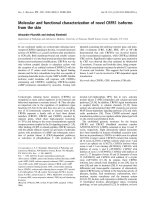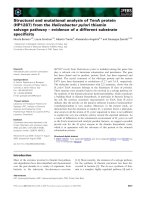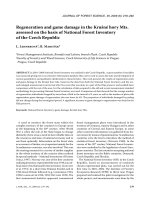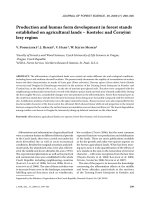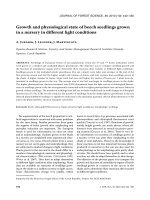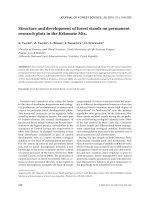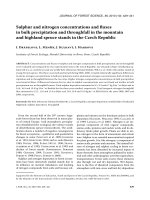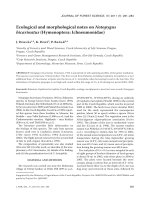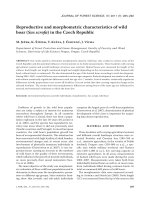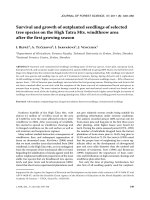Báo cáo lâm nghiệp: "ISSR and AFLP identification and genetic relationships of Chinese elite accessions from the genus Populus" ppt
Bạn đang xem bản rút gọn của tài liệu. Xem và tải ngay bản đầy đủ của tài liệu tại đây (1.74 MB, 8 trang )
Ann. For. Sci. 63 (2006) 499–506 499
c
INRA, EDP Sciences, 2006
DOI: 10.1051/forest:2006031
Original article
ISSR and AFLP identification and genetic relationships of Chinese
elite accessions from the genus Populus
Gao J
a
, Zhang S
b
,QiL
b
, Zhang Y
a
,WangC
a
, Song W
a
*
a
Laboratory of Cell Biology, College of Life Sciences, Nankai University, Tianjin 300071, P.R. China
b
Laboratory of Cell Biology, The Research Institute of Forestry, The Chinese Academy of Forestry, Beijing 100091, P. R. China
(Received 13 June 2005; accepted 10 November 2005)
Abstract – Inter-simple sequence repeat polymorphism (ISSR) and amplified fragment length polymorphism (AFLP) analysis techniques were used
in this study for the genetic fingerprinting and identification of 28 important Chinese poplar accessions. After fingerprinting, the genetic relationships
among the accessions were determined. Each of three ISSR primers and four AFLP primer pairs produced fingerprint profiles that were unique to each
of the accessions studied, and thus could be used solely for their identification. In general, the molecular data separated accessions from different poplar
sections, and also distinguished between native and exotic accessions. In conclusion, both ISSR and AFLP could be applied to identify large numbers of
poplar accessions, and could also be used to rapidly determine the genetic relationships among them. Furthermore, it is useful to conduct comparative
studies with different marker systems when investigating the genetic relationships of poplar accessions.
poplar / identification / genetic relationships / AFLP / ISSR
Résumé – Identification de cultivars de peuplier chinois à l’aide de marqueurs ISSR et AFLP et étude de leur relation génétique. Des marqueurs
ISSR et AFLP ont été testés dans cette étude dans un but de marquage génétique et d’identification de 28 cultivars chinois. Après leur caractérisation,
l’objectif était d’étudier la relation génétique entre ces cultivars. Chacun des 3 primers ISSR et des 4 paires de primers AFLP a produit des profils qui
se sont révélés uniques pour chacun des cultivars étudiés et qui peuvent être utilisés pour leur identification. Ces marqueurs ont également permis de
séparer les cultivars des différentes sections de peuplier et de distinguer les cultivars autochtones et exotiques. En conclusion, les marqueurs ISSR et
AFLP peuvent être utilisés pour identifier les cultivars de peuplier et également pour déterminer rapidement leur relation génétique. De plus, il semble
utile de conduire des études comparatives avec plusieurs types de marqueurs pour étudier les relations génétiques entre cultivars de peuplier.
Populus / marqueurs AFLP / ISSR / identification / relation génétique
1. INTRODUCTION
The genus Populus L. (Salicaceae), a genus of decidu-
ous trees, has a wide natural distribution in the Northern
Hemisphere, with 29 species grouped under six separate sec-
tions [7]. The most economically important species are in the
Aigeiros, Tacamahaca and Populus sections. In China, poplars
are not only economically important for the architecture, lum-
ber, and pulp and paper industries, but have also been widely
used for windbreaks and erosion control. The unit of cultiva-
tion and breeding in poplars is a clone, and normally the in-
dividual cultivar is represented by a single clone. A number
of poplar clones, cultivars and varieties are extensively cul-
tivated, many of which are endemic to China [38]. Accurate
identification of poplar cultivars and knowledge of their ge-
netic relationships are essential for breeding and management
strategies.
Traditionally, the process of clone and cultivar identifica-
tion, registration and certification in Populus has been based
on a method adopted by the International Poplar Commis-
sion. The technique is based on a combination of a total
* Corresponding author:
of 64 morphological, phenological and floral characteristics
[11]. However, this method of clone identification is diffi-
cult, time consuming and subjective. Since the late 1980s,
several molecular marker approaches have been successfully
used in a number of poplar species for the fingerprinting and
identification of clones and the determination of their inter-
relationship. Allozyme [10, 12, 27] and randomly amplified
polymorphic DNA (RAPD) [5, 17, 31] analyses were initially
used for this purpose because of their simplicity and rela-
tively low cost. However, the small numbers of polymorphism
present in allozyme and lack of reproducibility of RAPD limit
the usefulness of these markers. Recently, the hypervariabil-
ity, codominance and high reproducibility of SSR (simple se-
quence repeat) have led to its application for the fingerprinting
and identification of poplar cultivars [25,26].
Significant levels of DNA polymorphism in plants have
been revealed by amplified fragment length polymorphism
(AFLP) analysis [35]. It is an efficient and reliable genetic
molecular marker technique that detects a much higher num-
ber of polymorphisms per reaction than that revealed by RFLP,
RAPD or SSR assay [21,23]. Despite the fact that AFLP frag-
ments are usually analyzed as dominant markers the technique
Article published by EDP Sciences and available at or />500 G. Jianming et al.
Table I. List of poplar materials used in this study.
Code Accessions Species Section Country of origin
P1
P2
P3
P4
P5
Maobaiyang-CFG37
Hebeiyang-1
Yinbaiyang
Yinxingyang-2
Xingjiangyang
P. alba × P. adenopoda
P. hopeiensis
P. alba
P. alba × P. bolleana
P. bolleana
Populus China
China
China
China
China
T1
T2
T3
T4
T5
T6
T7
Xiaoyeyang-328
Qinghaiqingyang-107
Wutaiqingyang-77
BeiJingqingyang
Maoguoyang-309
Zhongqing-10
Zhongqing-48
P. simonii
P. cathayana
P. cathayana × P. simonii
P. cathayana
P. trichocarpa
P. cathayana
P. cathayana
Tacamahaca China
China
China
China
Canada
China
China
A1
A2
A3
A4
A5
A6
A7
A8
A9
A10
Jianadayang (Gu’an)
Oumeiyang-107
Liaoheyang
Langfang-2
Gaiyang
Liaoningyang (Fengning)
Liaoningyang (Dalian)
Liaoningyang (Gu’an)
Jianganyang
Oumeiyang-13
P. × euramericana
P. × euramericana
P. deltoides
P. deltoides
P. × euramericana
P. deltoides
P. deltoides
P. deltoides
P. nigra
P. × euramericana
Aigeir os Canada
Italy
China
China
China
China
China
China
China
Italy
TA1
TA2
TA3
TA4
TA5
Hezuoyang
Beijingyang-2
Zhongshang-8
Mamei (Hubei)
Qunzhongyang
P. nigra × P. simonii
P. nigra × P. cathayana
P. nigra × P. cathayana
P. deltoides × P. suaveolens
P. simonii × P. nigra
Tacamahaca ×
Aigeir os
America × China
America × China
Unkown × China
Italy × Japan
America × China
TU Huyang (Xingjiang) P. euphratica Turanga China
has been successfully applied to many kinds of plants such
as rice [18], wheat [3], vetch [22], tea [2] and larch [30]. In
poplar AFLP has been used to assess genetic diversity [32],
screen interspecific hybrids [6], determine the genetic struc-
ture of natural populations [1] and construct genetic linkage
maps [37].
Inter-simple sequence repeat polymorphism (ISSR) anal-
ysis overcomes many of the technical limitations of RFLP
and RAPD [34], and has higher reproducibility than RAPDs
[9, 20]. ISSR involves the PCR amplification of DNA using
single primers composed of sequences that target abundant,
rapidly evolving microsatellites throughout the eukaryotic
genome [15, 16, 33]. ISSR analysis has been used to assess
genetic diversity in maize [14] and beans [19], as well as to
identify cultivars of potatoes [24], barley [9] and citrus [8].
Currently, there are no reports in which ISSR has been applied
to fingerprinting poplar cultivars.
This study was aimed at the development of molecular
marker systems for both the rapid and accurate identification
of poplar accessions and the determination of genetic relation-
ships between these accessions at the DNA level. This paper
explores the potential of adopting AFLP and ISSR for high
throughput fingerprinting of poplar accessions and the deter-
mination of their genetic relationships.
2. MATERIALS AND METHODS
2.1. Plant materials
Cuttings from a single ramet of each accession listed in Table I
were planted in the collection of the Research Institute of Forestry at
the Chinese Academy of Forestry.
2.2. DNA extraction
DNA was isolated using the CTAB method according to Reichardt
and Rogers [28] with slight modifications. After the DNA pellet was
re-dissolved in Solution IV (10 mM Tris-HCl, 0.1 mM EDTA, 1
M NaCl, pH 8.0), it was treated with RNase A (200 ng/µL) for 60
min at 37
◦
C and was extracted with 1 volume mixture of chloro-
form:isoamylalcohol (24:1). Finally, the high molecular weight DNA
was checked for quality and quantity using agarose gel (0.8%) elec-
trophoresis and fluorimetry (ND-1,000 Spectrophotometer, Nano-
Drop).
2.3. ISSR and AFLP analysis
ISSR PCR reaction mixtures (20 µL) contained the following
components/concentrations: 10 mM Tris-HCl (pH 8.0), 1.5 mM
MgCl
2
,0.4µM of each primer, 0.2 mM of each dNTP (Shanghai
ISSR and AFLP fingerprinting of poplar 501
Table II. Fragments and polymorphism detected by three ISSR primers and four AFLP primers pairs.
Marker systems Primers
a
Total fragments Polymorphic Percent polymorphic Unique fragments Monomorphic
fragments fragments fragments
ISSR (GA)
8
RC 53 44 83% 9 0
(AC)
8
YA 42 36 86% 6 0
(AG)
8
YA 59 49 83% 10 0
Total 154 129 84% 25 0
Average 51 43 84% 8.1 0
AFLP 84 73 87% 9 2
E-ACT×M-CAA 78 62 79% 11 5
E-AAC×M-CAG 66 53 80% 7 6
E-AAG×M-CAA 77 64 83% 12 1
E-AAG×M-CTG 305 252 83% 39 14
Total Average 76 63 83% 9.8 3.5
a
R = AorT,Y= CorG.
Sangong, China), 2.5% formamide, 30 ng of template genomic DNA
and 1 U of Taq DNA polymerase (Toyobo, Japan). DNA amplifica-
tions were performed in a Mastercycler Gradient 5331 (Eppendorf,
Germany) using the following touchdown program: 3 min at 94
◦
C
for 1 cycle; 30 s at 94
◦
C, 60 s at 62
◦
C and 80 s at 72
◦
C for 1 cycle;
annealing temperature at 62
◦
C was subsequently reduced by 1
◦
Cfor
the next 10 cycles and remained at 52
◦
C for the remaining 24 cycles;
7minat72
◦
C for 1 cycle.
The AFLP method was performed essentially according to Vos
et al. [35] with minor modifications. Briefly, 100-150 ng of genomic
DNA was digested with 1.5 U of both EcoRIandMse I (Shang-
hai Sangon, China). After ligation of adapters and pre-amplification,
selective amplification was conducted by combining 30 ng of both
EcoRIandMse I primers that contain three selective nucleotides.
Amplification products were separated on 4% denaturing poly-
acrylamide gels running at 30 W for 2 h (ISSR) or on 6% denaturing
polyacrylamide gels running at 30 W for 1.5 h (AFLP) in 1×TBE
buffer. After silver staining [4], the gels were dried at room tempera-
ture and photographed.
In a preliminary experiment, 32 ISSR primers and 64 AFLP
primer pairs were tested for selective amplification. Of these, three
ISSR primers and four AFLP primer pairs that generated good pat-
terns were selected for use in this study (Tab. II). Two independent
PCR amplifications were performed using the selected ISSR primers
and AFLP primer pairs, and the products were separated on indepen-
dent gels. In addition, two DNA extraction replicates of a subset of
samples (L5, T2, T6, A2 and A8) were conducted to assess the repro-
ducibility of the band profiles.
2.4. Data analysis
Both ISSR and AFLP bands behave as dominant markers. The
band profiles of each primer (primer pair) were manually scored on
two occasions for the presence (1) or absence (0) of co-migrating
fragments for all accessions. Only reproducible bands across two
PCR amplification replicates were used in the subsequent analysis.
The scored fragment sizes ranged from 200 to 1,500 bp for ISSR
and 100 to 400 bp for AFLP. The genetic relationships among the
accessions were determined by calculating the simple matching coef-
ficient (SM). The resultant pairwise similarity matrix was employed
to construct cluster plots by the unweighted pair group method with
arithmetic mean (UPGMA). For each dendrogram, the cophenetic co-
efficient between the matrix of similarity coefficient and the matrix of
cophenetic value was calculated with Mantel matrix correspondence
tests. Significance of the cophenetic coefficients was determined by
5,000 permutations. Correlation coefficients between the matrices of
similarity coefficients were calculated and tested as above. In addi-
tion, principal coordinate analysis (PCA) on the correlation coeffi-
cient was conducted to visualize the dispersion of the individuals in
relation to the first two principal axes of variation. The NTSYS-PC
software package version 2.02 [29] was used for the cluster analy-
sis, the PCA analysis and the Mantel test. Bootstrap analysis, with
1 000 re-samples, was computed using Win boot [37] to determine
the confidence limits of the UPGMA dendrogram. The 0/1matrixis
available to readers upon request.
3. RESULTS
3.1. Fingerprint patterns and cultivars identification
In the current experiment, consistent results were obtained
across two DNA extraction replicates for the two marker sys-
tems, with over 98% of scorable fragments reproducible for
ISSR and 99% for AFLP. Very faint fragments were not repro-
ducible, thus such fragments were not scored in this study.
ISSR amplification from all samples resulted in multiple
band fingerprint profiles (Fig. 1, Tab. II). Each of the three
primers produced fingerprint profiles unique to the accessions
studied. Therefore, it was possible to distinguish between all
of the accessions. The average number of scorable fragments
per primer was 51, with a range from 42 [(AC)
8
SA] to 59
[(AG)
8
SA], and the average number of polymorphic fragments
per primer was 43, with a range from 36 [(AC)
8
SA] to 49
[(AG)
8
SA]. Of the total 154 scorable fragments, 129 (84%)
were polymorphic among the accessions, and 25 were unique
to 11 of the studied cultivars (data not shown).
502 G. Jianming et al.
Figure 1. ISSR fingerprint pattern generated using primer (GA)
8
RC.
Similarly, the accessions studied could be uniquely finger-
printed and differentiated by each of four AFLP primer pairs
(Fig. 2, Tab. II). The average number of scorable fragments
per primer was 76, with a range from 66 (E-AAG×M-CAA) to
84 (E-ACT×M-CAA), while the average number of polymor-
phic fragments per primer was 63, with a range from 53 (E-
AAG×M-CAA) to 73 (E-ACT×M-CAA). Of the 305 scorable
AFLP fragments, 252 (83%) were polymorphic among the ac-
cessions, 14 were monomorphic among the accessions, and
39 fragments were unique to 15 of the cultivars studied (data
not shown).
3.2. Inter-cultivars genetic relationships
The Mantel test of the correlation coefficient between the
two similarity matrices (data not shown) based on ISSR and
AFLP showed a high value with r = 0.84 (P < 0.0004, Good
fit). The similarity coefficients for the 378 possible pairs of
28 poplar accessions ranged from 0.513 to 0.961 for ISSR
and from 0.440 to 0.944 for AFLP. Accessions belonging to
Populus and cultivars belonging to Tacamahaca, Aigeiros and
Tacamahaca × Aigeiros shared very low genetic similarity
with coefficients ranging from 0.513 to 0.695 for ISSR and
from 0.440 to 0.635 for AFLP.
The dendrograms (Fig. 3) based on the two marker systems
were truly representative of their similarity matrices since the
cophenetic correlation values were 0.875 (P < 0.0004, Good
fit) for ISSR and 0.946 (P < 0.0004, Very good fit) for AFLP.
However, they were not indicative of grouping according to
poplar sections, because the bootstrap values of some of clus-
ters were lower than 50%. However, accessions from Populus
were always in the same cluster while accessions from Pop-
ulus deltoides clustered together. An overview of the genetic
similarities between poplar sections may be obtained by PCA
analysis. The results of the two PCA plots (Fig. 4) were gener-
ally consistent, each dividing the 28 accessions into five major
groups: All Populus accessions were grouped into cluster I and
all those accessions from Populus deltoides formed cluster III.
The only accession from the Turanga section, P. euphratica,
was the sole member of cluster II. Most of the accessions with
exotic origins were from Tacamahaca, Aigeiros or Tacama-
haca × Aigeiros, and grouped in cluster IV, while cluster V in-
cluded most of accessions native to China from Tacamahaca,
Aigeiros or Tacamahaca × Aigeiros.
4. DISCUSSION
The results of this work clearly demonstrate that both
AFLP and ISSR markers can be used for the identification
of poplar accessions. In fact, all of the analysed accessions
were uniquely identified both by their AFLP fingerprints and
by their ISSR profiles. It is worth noting that each accession
produced its own unique AFLP and ISSR fingerprinting pro-
file using any one of the ISSR and AFLP primers. Therefore,
any of the primers could be used separately to identify these
cultivars in the future.
ISSR and AFLP fingerprinting of poplar 503
Figure 2. AFLP fingerprint pattern generated using primer pair E-AAG×M-CAA.
In addition to providing the facility to identify individual
accessions, the ISSR markers and AFLP markers also tended
to reveal those accessions that were closely related. For ex-
ample, our data showed that A4, A6, A7 and A8 were closely
related. In fact, this was accordant with their origin. A6, A7
and A8 belong to the cultivar “Liaoningyang” which is the
product of a cross between “I-69 (Populus deltoides Bartr. cv.
‘Lux’ ex I-69/55) and Populus deltoides cv. Shanhaiguanen-
sis”. This cultivar consists of 6 clones that are difficult to dis-
criminate morphologically [39]. In addition, A4, although not
the same cultivar, originated from the same cross as “Liaon-
ingyang” [39]. In the cluster plots, these four accessions were
grouped into a cluster with a higher similarity level.
The two PCA plots (Fig. 4), to some extent, showed a sep-
aration of cultivars among different sections of the poplar, and
differentiated between accessions that were native to China
and those of exotic origin. However, the PCA plots and the
cluster plots grouped the accessions from Tacamahaca with
those from Aigeiros; and groups IV and V each included acces-
sions from Tacamahaca, Aigeiros or Tacamahaca × Aigeiros.
The molecular data may also highlight incorrect identifica-
tions. For example, T6 and T7 were identified as members
of Populus cathayana in the Tacamahaca section which orig-
inated in China. However, these did not group into a single
cluster with the other accessions of this species that had their
origin in China (T2, T3 and T4). Instead, they were placed in a
cluster in which most of the accessions (A1, A2, A10, T5 and
TA4) are of exotic origin. Thus, the identities or the origins of
these two accessions of Populus cathayana are questionable.
Further experiments are needed to clarify these issues with ad-
ditional ISSR primers or AFLP primer pairs or through other
methods.
The data also indicate that AFLP is more effective than
ISSR since, on average, more polymorphic fragments could
be obtained from an AFLP primer pair than from an ISSR
primer (43 for ISSR and 63 for AFLP). However, ISSR has
the distinct advantage of offering a simpler methodology and
is thereby easier to implement than AFLP. Both marker sys-
tems provided broadly similar results in determining the ge-
netic relationships of poplar accessions. However, the fact that
some differences existed between corresponding clusters in the
two PCA plots and the two dendrograms indicates that it is
useful to conduct comparative studies of the different marker
systems when determining the genetic relationships of poplar
cultivars. The differences could be partially explained by the
different number of PCR fragments analyzed (129 for ISSR
and 252 for AFLP). This possibility reinforces the importance
of the number of fragments and their coverage of the overall
genome. Alternatively, it could be that the two marker systems
target different genomic DNA sequences that exhibit slightly
different levels of variation.
504 G. Jianming et al.
Figure 3. UPGMA dendrogram using ISSR and AFLP. The numbers at the forks indicate the confidence limits for the grouping of those
accessions, which are to the right of that fork. Only bootstrap values greater than 50% are reported.
Figure 4. Principal coordinate analysis (PCA) using ISSR and AFLP. Variation explained by the first principal component (Z1) is 22% for
ISSR and 26% for AFLP, and is 17% for ISSR and 13% for AFLP for the second principal component (Z2).
ISSR and AFLP fingerprinting of poplar 505
As with other DNA molecular techniques, such as RFLP,
RAPD and SSR, an obvious advantage of AFLP and ISSR over
traditional, morphologically based methods is that there is an
immense number of markers that can be generated rapidly and
are not affected by environmental factors. In fact, molecular
techniques vary in the way that they resolve genetic differ-
ences, in the type of data they generate and in the taxonomic
levels at which they can be most appropriately applied. The
AFLP and ISSR analysis techniques can detect much higher
numbers of polymorphisms per reaction than RFLP, RAPD
and SSR assays. Moreover, the results of this study show that
fingerprinting profiles based on ISSR and AFLP can be highly
replicable in the same laboratory. Indeed Jones et al. showed
that the between-laboratory error for AFLP markers was less
than 0.6% [13], indicating that AFLP can also be highly repli-
cable across laboratories. Thus, AFLP or ISSR markers could
prove very useful for the rapid and accurate identification of
large numbers of poplar accessions and for the determination
of their genetic relationships. Although it is sometimes more
difficult to compare from lab to lab and process band data for
these two methods than for SSR, if the appropriate reference
samples are used to standardize band scoring across laborato-
ries, the problems will be possibly solved.
It is essential for future breeding programs that the genetic
diversity and genetic relationships of the native and exotic
germplasm resources in poplar be determined using a variety
of molecular markers. In particular, the poplar seedling indus-
try requires a reliable means of cultivar identification that can
be applied routinely to large numbers of samples. The present
work has demonstrated that ISSR and AFLP could be used for
these purposes.
Acknowledgements: The authors are very grateful to the review-
ers for comments on the manuscript, Ms. Dunlian Qiu from Sichuan
Academy of Agricultural Sciences of China for helpful suggestions
on the manuscript, the following people for their assistance in ob-
taining poplar materials: Yuquan Zhou and Jianzhong Ren from Da-
tong in Shanxi province, Zhangshui Chen from Shunyi and Huairou
in Beijing Drs. This study was supported by grants from National
“948” Program (No. 98-4-04-02) and National Key Basic Research
Program (“973”) (G19990160) – “Molecular Research on Trees Im-
provement”.
REFERENCES
[1] Arens P., Coops H., Jansen J., Vosman B., Molecular genetic analy-
sis of black poplar (Populus nigra L.) along Dutch rivers, Mol. Ecol.
7 (1998) 11–18.
[2] Balasaravanan T., Pius P.K., Raj Kumar R., Muraleedharan N.,
Shasany A.K., Genetic diversity among south Indian tea germplasm
(Camelliasinensis, C. assamica and C. assamica spp. lasiocalyx)
using AFLP markers, Plant Sci. 165 (2003) 365–372.
[3] Barrett B.A., Kidwell K.K., AFLP-based genetic diversity assess-
ment among wheat cultivars from the Pacific North-west, Crop Sci.
38 (1998) 1261–1271.
[4] Bassam B.J., Caetano-Anolles G., Gresshoff P.M., Fast and sensi-
tive silver staining of DNA in polyacrylamide gels, Anal. Biochem.
196 (1991) 80–83.
[5] Castiglione S., Wang G., Damiani G., Bandi C., Bisoffi S., Sala F.,
RAPD fingerprints for identification and taxonomic studies of elite
poplar (Populus spp.) clones, Theor. Appl. Genet. 87 (1993) 54–59.
[6] Chauhan N., Negi M.S., Sabharwal V., Khurana D.K.,
Lakshmikumaran M., Screening interspecific hybrids of Populus
(P. ciliata × maximowiczii) using AFLP markers, Theor. Appl.
Genet. 108 (2004) 951–957.
[7] Eckenwalder J.E., Systematics, evolution of Populus. In: Stettler
R.F., Bradshaw H.D. Jr., Heilman P.E., Hinckley T.M. (Eds.),
Biology of Populus and its implications for management and con-
servation, Ottawa, NRC Research Press, 1996, pp. 7–32.
[8] Fang D.Q., Roose M.L., Identification of closely related citrus culti-
vars with inter-simple sequence repeat markers, Theor. Appl. Genet.
95 (1997) 408–417.
[9] Fernández M.E., Figueiras A.M., Benito C., The use of ISSR and
RAPD markers for detecting DNA polymorphism, genotype iden-
tification and genetic diversity among barley cultivars with known
origin, Theor. Appl. Genet. 104 (2002) 845–851.
[10] Heinze B., PCR-based chloroplast DNA assay for the identification
of native Populus nigra and introduced poplar hybrids in Europe,
For. Genet. 5 (1998) 31–38.
[11] IUPOV, Guidelines for the conduct of tests for distinctness, ho-
mogeneity and stability Popul us L., International Union for the
Protection of New Varieties of Plants, Geneva, Switzerland, 1981.
[12] Janssen A., Unterscheidung der beiden Schwarzpappelarten
Populus nigra L. und P. deltoides Marsh. sowie ihrer
Arthybride P. × euramericana (Dode) Guinier mit Hilfe von
Isoenzymmmustern, Holzzucht 51 (1997) 17–23.
[13] Jones C.J., Edwards K.J., Castaglione S., Winfield M.O., Sala F.,
van de Wiel C., Bredemeijer G., Vosman B., Matthes M., Daly A.,
Brettschneider R., Bettini P., Buiatti M., Maestri E., Malcevschi
A., Marmiroli N., Aert R., Volckaert G., Rueda J., Linacero R.,
Vazquez A., Karp A., Reproducibility testing of RAPD, AFLP and
SSR markers in plants by a network of European laboratories, Mol.
Breed. 3 (1997) 381–390,
[14] Kantety R.V., Zeng X.P., Bennetzen J.L., Zehr B.E., Assessment of
genetic diversity in dent and popcorn (Zea mays L.) inbred lines us-
ing inter-simple sequence repeat (ISSR) amplification, Mol. Breed.
1 (1995) 365–373.
[15] Kijas J.M.H., Fowler J.C.S., Thomas M.R., An evaluation of se-
quence tagged microsatellite site markers for genetic analysis
within Citrus and related species, Genome 38 (1995) 349–355.
[16] Levinson G., Gutman G.A., Slipped-strand mispairing: a major
mechanism for DNA sequence evolution, Mol. Biol. Evol. 4 (1987)
203–221.
[17] Lin D., Hubbes M., ZsuffaL.,Differentiation of poplar and wil-
low clones using RAPD fingerprints, Tree Physiol. 14 (1994) 1097–
1105.
[18] Mackill D.J., Zhang Z., Redona E.D., Colowit P.M., Level of poly-
morphism and genetic mapping of AFLP markers in rice, Genome
39 (1996) 969–977.
[19] Métais I., Aubry C., Hamon B., Jalouzot R., Description and analy-
sis of genetic diversity between commercial bean lines (Phaseolus
vulgaris L.), Theor. Appl. Genet. 101 (2000) 1207–1214.
[20] Meyer W., Mitchell T.G., Freedman E.Z., Vilgalys R.,
Hybridization probes for conventional DNA fingerprinting used
as single primers in the polymerase chain reaction to distinguish
strains of Cryptococcus neoformans, J. Clin. Microbiol. 31 (1993)
2274–2280.
[21] Pejic I., Ajmone-Marsan P., Morgante M., Kozumplick V.,
Castiglioni P., Taramino G., Motto M., Comparative analysis of
genetic similarity among Maize in bred lines detected by RFLPs,
RAPDs, SSRs, and AFLPs, Theor. Appl. Genet. 97 (1998) 1248–
1255.
[22] Potokina E., Blattner F.R., Alexandrova T., Bachmann K., AFLP
diversity in the common vetch (Vicia sativa L.) on the world scale,
Theor. Appl. Genet. 105 (2002) 58–67.
[23] Powell W., Morgante M., Andre C., The comparison of RFLP,
RAPD, AFLP and SSR (microsatellite) markers for germplasm
analysis, Mol. Breed. 2 (1996) 225-238.
506 G. Jianming et al.
[24] Prevost A., Wilkinson M.J., A new system of comparing PCR
primers applied to ISSR fingerprinting of potato cultivars, Theor.
Appl. Genet. 98 (1999) 107–112.
[25] Rahman M.H., Rajora O.P., Microsatellite DNA fingerprinting, dif-
ferentiation, and genetic relationships of clones, cultivars, and vari-
eties of six poplar species from three sections of the genus Populus,
Genome 45 (2002) 1083–1094.
[26] Rajora O.P., Rahman M.H., Microsatellite DNA and RAPD finger-
printing, identification and genetic relationships of hybrid poplar
(Popul us × canadensis) cultivars, Theor. Appl. Genet. 106 (2003)
470–477.
[27] Rajora O.P., Characterization of 43 Populus nigra L. clones rep-
resenting selections, cultivars and botanical varieties based on their
multilocus allozyme genotypes, Euphytica 43 (1989) 197–206.
[28] Reichardt M.J., Rogers S.J., Plant DNA isolation using CTAB, In:
Ausubel F.M., Brent R., Kingston R.E., Moore D.D., Seidman J.G.,
Smith J.A., Struhl K. (Eds.), Current protocols in molecular biology,
USA, John Wiley and Sons, Suppl. 22, 1993.
[29] Rohlf F.J., NTSYS-PC numerical taxonomy and multivariate anal-
ysis system, version 2.02, Exeter Software, New York, 1998.
[30] Semerikov Vladimir L., Hengqing Z., Lascoux S.M.M., Conflicting
phylogenies of Larix (Pinaceae) based on cytoplasmic and nuclear
DNA, Mol. Phylogenet. Evol. 27 (2003) 173–184.
[31] Sigurdsson V., Anamthawat-Jonsson K., Sigurgeirsson A., DNA
fingerprinting of Populus trichocarpa clones using RAPD markers,
New For. 10 (1995) 197–206.
[32] Storme V., Vanden Broeck A., Ivens B., Halfmaerten D., Van
Slycken J., Castiglione S., Grassi F., Fossati T., Cottrell J.E.,
Tabbener H.E., Lef vre F., Saintagne C., Fluch S., Krystufek V.,
Burg K., Bord cs S., Borovic A., Gebhardt K., Vornam B., Pohl A.,
Alba N., Agndez D., Maestro C., Notivol E., Bovenschen J., van
Dam B.C., van der Schoot J., Vosman B., Boerjan W., Smulders
M.J.M., Ex-situ conservation of Black poplar in Europe: genetic
diversity in nine gene bank collections and their value for nature
development, Theor. Appl. Genet. 108 (2004) 969 –981.
[33] Tautz D., Renz M., Simple sequences are ubiquitous repetitive
components of eukaryotic genomes, Nucleic Acids Res. 12 (1984)
4127–4138.
[34] Tsumura Y., Ohba K., Strauss S.H., Diversity, inheritance
of inter-simple sequence repeat polymorphisms in Douglas–fir
(Pseudotsuga menziesii) and sugi (Cryptomeria japonica), Theor.
Appl. Genet. 92 (1996) 40–45.
[35] Vos P., Hogers R., Bleeker M., Reijans M., Lee T., Hornes M.,
Frijters A., Pot J., Peleman J., Kupier M., Zabeau M., AFLP: A new
technique for DNA fingerprinting, Nucleic Acids Res. 23 (1995)
4407–4414.
[36] Yap I.V., Nelson R.J., WINBOOT a program for performing boot-
strap analysis of binary data to determine the confidence limits of
UPGMA-based dendrograms, IRRI Disc. Pap. Ser. 14, International
Rice Research Institute, Manila, Philippines, 1996.
[37] Zhang D., Zhang Z., Yang K., Li B., Genetic mapping in (Popul us
tomentosa × Populus bolleana)andPopulus tomentosa Carr. using
AFLP markers, Theor. Appl. Genet. 108 (2004) 657 –662.
[38] Zhao Tianxi, Chen Zhangshui, The poplar intensive cultivation in
China. Beijing, China Science Technology Press, 1994, pp. 9–13.
[39] Zheng Shikai, Li Yumin, Lu Xinzheng, Introduction to poplar vari-
eties (IV), Pract. For. Technol. 2 (2003) 12–13.
To access this journal online:
www.edpsciences.org
